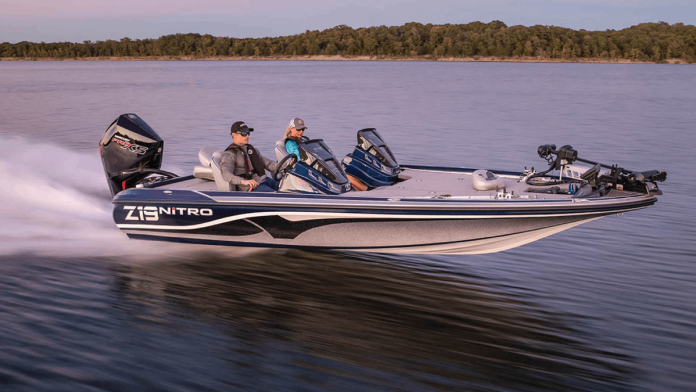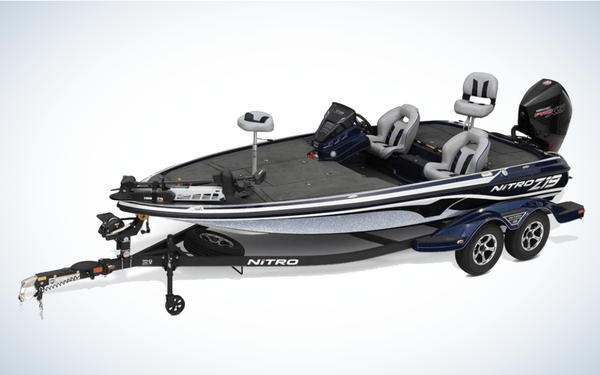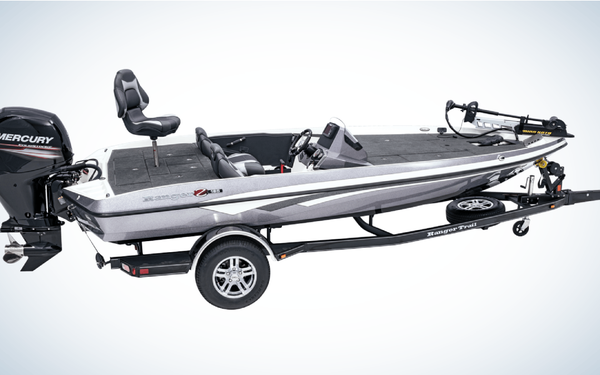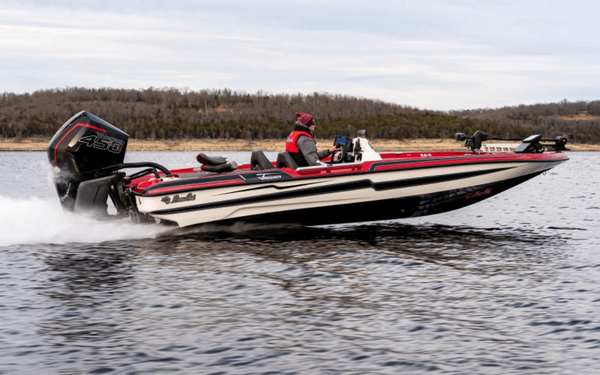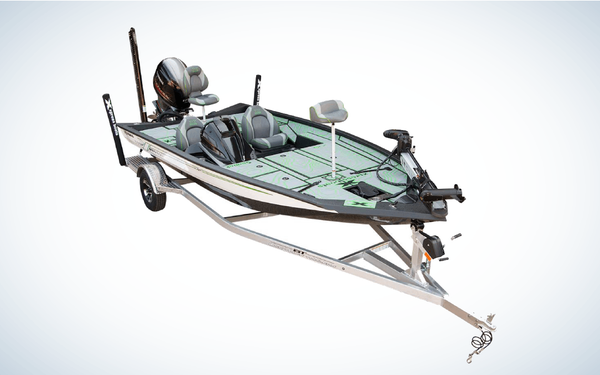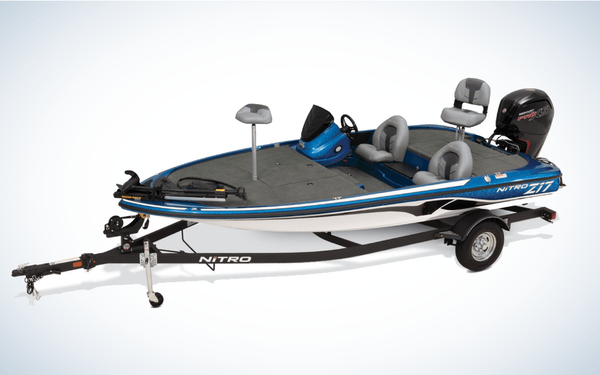We may earn revenue from the products available on this page and participate in affiliate programs. Learn more ›
Like the best fishing boats, the sight of a sleek, metal flake-clad bass boat on the way to the lake is enough to make an angler’s head turn and dream about the adventures these modern marvels open up for their owners. Getting away from the shoreline and roaming the water in search of largemouth, smallmouth, and spotted bass is one of the most freeing forms of fishing a person can enjoy.
At blast-off, a bass boat rockets an angler to his or her destination ahead of the competition. Then it must transform into a comfortable fishing platform that’s both heavy enough to handle wind and waves without being pushed from an offshore sweet spot and agile enough to slip quietly into shallow weed-filled backwaters with little more than a foot of water. And it does this all while storing the angler’s rods, reels, and other tackle needed to land and weigh in a limit of plus-sized prize money fish by weigh-in.
Luckily there really are no “bad boats” floating around in the new boat market. For most, it comes down to the fit, finish and little extras (like built-in boat coolers) that guide the final decision on the best bass boats.
How We Picked the Best Bass Boats
The good news is that modern bass boat manufacturers have pretty much perfected the craft of designing stable, fast hulls that are dependable. No truly “bad boats” are being turned out by major manufacturers in today’s market. But premium features require premium prices, meaning that most anglers will only buy one or two bass boats in a decade of fishing.
As a tournament angler who participates in regional level tournaments from the back of the boat and a writer who works with fishing guides who spend more waking hours on board their boats than ashore, I’ve whittled down the features and factors that matter. They deliver a lineup of fishing machines that deliver a comfortable ride, a stable and effortless fishing platform and accessories where they’re needed without overloading the package and inflating the price tag to a point that’s untouchable for the everyday angler.
Specs
- Length: 19 feet, 4 inches
- Width (Beam): 94 inches
- Max Recommended HP: 200
- Fuel Capacity: 50 gal.
- Livewell Capacity: 38 gal. (divided)
Pros
- Huge padded deck offers all-day comfort for two anglers to fish from the front.
- Total package price under $50,000 is incredible for a 200 hp rig in today’s market
- Access to multiple brands of electronics and trolling motors allow you to accessorize without changing brands or special ordering new gear.
- Low gunnels make the most of the boat’s width to give you as much room as possible to fish.
- Smaller outboard requirement offers excellent fuel efficiency for size.
- Accessory holders are well thought out to reduce fumbling for gear and maximize fishing time.
Cons
- Separate livewells lack the length needed for larger species such as pike, musky, and large striped bass.
- Back deck is a bit cramped for anglers who fish with a partner
- Lower 200 hp rating is fuel-efficient, but makes the boat a tad slower than a few other 20-foot models
Each year, it seems someone comes up with a new gadget or feature to add to their top-of-the-line bass boat model to separate it from the crowd, like a special recessed trolling motor tray, wide platform for bow electronics, or padded decks for all-day standing comfort (many of which you can do yourself with these cheap bass boat upgrades). What did Nitro do in the Z19 that was so different? Nothing, and everything. Just about every “special” feature released by other manufacturers during the last few years is incorporated into the Z19, and it’s done for the standard package with no hidden add-ons to give you the boat you want without haggling over details.
The aggressively concave outer hull directs water away from the sides of the boat to offer a dry ride in heavy chop while the 16-degree deadrise in the hull ensures the boat can handle a ride back to the ramp when the wind has white caps flowing across the lake. With a Mercury 200 hp ProXS, the X19’s top speed hovers near 70 mph, depending on your prop and weight distribution. This might be a bit on the thin side for some speed-obsessed anglers or professionals running for more than an hour to a fishing destination in a large tournament, but it’s more than enough speed to be competitive in any regional events, especially with the recent trend of start-in-place tournaments beginning to become popular.
The Z19 really begins to shine, however, when you take it off pad and get to fishing. The front deck is massive, with 34 square feet of space. That’s plenty of room for you and a partner to fish side-by-side. And although it feels like you’re fishing from a giant boat, you can still access remarkably shallow water. Nitro lists that it drafts only 15 inches of water, and even with two anglers, it holds true to that specification.
You could just about carry an entire Bass Pro Shops store in all the storage locations available on this slick fishing platform, including our experts’ favorite spinning reels for bass and the best bass lures. Two removable boxes in the rear deck are molded to hold seven Plano-style tackle trays, and a cavernous center storage compartment under the front deck has room for dozens more. The step up to the front deck hides a cooler to serve up ice-cold drinks whether you’re on the deck or at the console, and five cup holders located strategically around the boat keep them that way. Lockable rod lockers on both sides of the deck have enough length to fit 8-foot long cranking rods and flipping sticks. The recessed foot-pedal tray at the bow has plenty of room to give you a level center of gravity in rough waves, and it has a convenient cup holder and tool-holder tray right at the front of your food, which makes reaching for the pliers to unhook your catch happen without a second thought. Recessed navigation lights on the bow eliminate any need to snap in old-school post lights to stay legal in low light hours.
The only real knock I could give to the storage came in the way you store your day’s catch. Instead of one large livewell with a divider, Nitro keeps the two 19-gallon livewells separate. This keeps weight down if you only need to use one livewell on a solo trip, but it does prevent the use of an ultra-wide well should you happen upon a larger musky, pike or striped bass that you want to take back to shore.
The most important feature of the boat, however, is the fact that you get all these premium add-ons at a standard price that still rests under the $50,000-mark, which is nearly impossible to find in a near 20-foot bass boat in today’s market.
Best Bass Boats: More Recommendations
Best for Beginners: Ranger Z185
A solid entry-level boat built to the highest standards and equipped well enough that you may never want to upgrade.
Best Large: Bass Cat Jaguar STS
Matched with a magnum-sized outboard, this beast of a boat not only flies on the water, but offers a comfortable ride and fishing experience in heavy, big-water waves.
Best Aluminum: Xpress X19 Pro
A lightweight, rugged fuel-efficient performer for skinny water anglers and those who still want top-shelf performance without the expense or weight of a fiberglass boat.
Best Small: Nitro Z17
A wide-decked fiberglass option for small to midsize waters that scoots across the surface with fewer ponies backing it up.
FAQs
What is the best size for a bass boat?
“We’re going to need a bigger boat,” isn’t a term any boat captain likes to hear. At the same time, you also need to remember how much power it’s going to take to move your boat. Not only do larger boats need larger engines, they also need larger trolling motors, and more capable tow-vehicles. If you have a heavy-duty truck and the funds to fuel bigger motors, by all means go with the bigger boats pushing 22 feet long, but if you’re limited by available fuel funds, towing package, and storage space, any bass boat 17 feet or larger will perform admirably well. A modest 18- to 19-foot boat matched with a 150- to 175-hp outboard will provide all the speed you need and fishes two anglers without any need for more space.
How much HP do I need for a bass boat?
Most high-performance bass boats are designed to accommodate outboards from 150 to 250 horsepower. Each manufacturer is required to list the maximum horsepower allowed for that boat, which follows a specific safety standard set by the U.S. Coast Guard. Just remember that as the horsepower goes up, your speed (and fuel consumption) will follow. No matter which boat model you choose, pick an outboard that’s at the maximum recommended horsepower for that vessel, otherwise you’ll always be wanting more.
Are there any fuel efficient bass boats?
If you’re focused on fuel efficiency, you have two options: downsize or go aluminum. The lighter weight of a smaller 17-foot boat or aluminum hull will require smaller outboards to push them across the water. They’ll also require less power from a trolling motor allowing smaller batteries and less energy consumption on that front as well.
How long do bass boats last?
The lifespan of a bass boat is solely dependent of the owner and their attention to detail in storage. Fiberglass bass boats aren’t made to sit in the weather unprotected for years on end. With that being said, there are still many models of Ranger boats, Skeeter boats and Bass Cats that are over four decades old that still see weekly use in local fishing derbies.
Final Thoughts on the Best Bass Boats
The best bass boats are as unique as their owners, and every bass angler is going to look for certain features that fit their style of fishing. For someone wanting to step up their bass fishing game outside of upgrading your fishing line or bass jigs, these options cover all the bases.
Why Trust Us
For more than 125 years, Field & Stream has been providing readers with honest and authentic coverage of outdoor gear. Our writers and editors eat, sleep, and breathe the outdoors, and that passion comes through in our product reviews. You can count on F&S to keep you up to date on the best new gear. And when we write about a product—whether it’s a bass lure or a backpack—we cover the good and the bad, so you know exactly what to expect before you decide to make a purchase.

